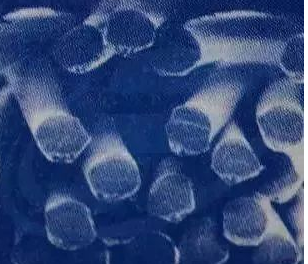The main source of chemical fiber is oil, so some people joke that "this is an era of wearing oil", then what is the past life of chemical fiber?
From "quantity" to "quality", from conventional products to new products
A feature of this phase is the flood of new products. Both the modification of the first generation of chemical fibers and the research and development of a new generation of chemical fibers. If divided by performance, the large varieties of chemical fibers that have been industrialized from the 1930s to 50 years can be called first-generation chemical fibers or conventional chemical fibers. These fibers are mainly used in the field of clothing. The new generation of chemical fiber mainly refers to the above mentioned differential fiber, functional fiber and high performance fiber. Since differentiated fibers are new products derived from large varieties of conventional fibers, some of them (such as colored fibers) have become conventional chemical fibers with the expansion of production.

Another characteristic of this phase is its long duration. Its origins can be traced back to the 1960s. For example:
1960 viscose based carbon fiber, imitation silk (triangular shape)
1962 meta aromatic polyamide fiber
1965 para-aromatic polyamide fiber
A hollow fiber artificial kidney from 1967
1970 polyacrylonitrile based carbon fiber, etc.
The high point of development was in the 1980s and 1990s. A large number of differentiated fiber products are transformed from technology into products. Its light Monsanto company launched more than 250 colored fibers in 1987. Japan introduced the "new synthetic fiber" in 1988. The production of high-performance fibers is increasing, and the variety is increasing. Polybenzodioxazole (PBO) fiber is its representative. A number of new functional fibers such as far-infrared, anti-ultraviolet and negative ions have been developed. At the same time, smart fibers, known as the third generation of chemical fibers, began to emerge, such as the United States Gateway company (now renamed Outlast Technology company) began to produce and sell heat storage and temperature control fibers in 1997.
In the process of developing new products of chemical fibers, some new spinning methods have been formed. Among them, there are mainly shaped spinneret spinning, composite spinning, wet and dry spinning, gel spinning, liquid crystal spinning, emulsion spinning, carrier spinning, phase separation spinning, centrifugal spinning, eddy current spinning, flash spinning, high-speed air melt-blowing, electrospinning and film cutting and fibrillating.

This stage has continued into the 21st century, organic-inorganic hybrid fibers, nanofibers and other research is in the ascends, and will continue. In particular, smart fibers will fully show their charm as the third generation of chemical fibers in the 21st century.
Finally, another important type of fiber should be mentioned - ecological fiber. It is different from the first, second, and third generation chemical fibers, and the difference from other fibers is not its properties, but its relationship with the environment. Due to the large amount of "three wastes" produced in the process of chemical fiber production, especially the production of viscose fiber has caused serious pollution to the environment; Moreover, the existing synthetic fiber is based on non-renewable petroleum resources, and most of its waste is non-degradable, so the research and development of renewable resources, clean production process and degradable waste fibers meet the requirements of sustainable development, and become a hot spot of international research and development.
The development of ecological fibers can be traced back to the 1960s. For example, in 1962, the American Cyanamid company made an excellent absorbable suture with polylactic acid. In 1969, Eastmann Kodak patented a new solvent for cellulose, methyl morpholine oxide (NMMO). Since the 1990s, a number of ecological fibers have been industrialized. The most representative of them are Lyocell fiber and polylactic acid fiber. In addition, although the amount of chitin and chitosan fiber, collagen fiber, alginate fiber is not large in the field of clothing, it has achieved an important position in the medical field. Regenerated protein fibers, such as soybean protein fibers, which had been short-lived in the 1930s and 1940s, also received renewed attention because of their ecological fiber characteristics.
- EMERSON
- Honeywell
- CTI
- Rolls-Royce
- General Electric
- Woodward
- Yaskawa
- xYCOM
- Motorola
- Siemens
- Rockwell
- ABB
- B&R
- HIMA
- Construction site
- electricity
- Automobile market
- PLC
- DCS
- Motor drivers
- VSD
- Implications
- cement
- CO2
- CEM
- methane
- Artificial intelligence
- Titanic
- Solar energy
- Hydrogen fuel cell
- Hydrogen and fuel cells
- Hydrogen and oxygen fuel cells
- tyre
- Chemical fiber
- dynamo
- corpuscle
- Pulp and paper
- printing
- fossil
- FANUC
- Food and beverage
- Life science
- Sewage treatment
- Personal care
- electricity
- boats
- infrastructure
- Automobile industry
- metallurgy
- Nuclear power generation
- Geothermal power generation
- Water and wastewater
- Infrastructure construction
- Mine hazard
- steel
- papermaking
- Natural gas industry
- Infrastructure construction
- Power and energy
- Rubber and plastic
- Renewable energy
- pharmacy
- mining
- Plastic industry
- Schneider
- Kongsberg
- NI
- Wind energy
- International petroleum
- International new energy network
- gas
- WATLOW
- ProSoft
- SEW
- wind
- ADVANCED
- Reliance
- YOKOGAWA
- TRICONEX
- FOXBORO
- METSO
- MAN
- Advantest
- ADVANCED
- ALSTOM
- Control Wave
- AB
- AMAT
- STUDER
- KONGSBERG
- MOTOROLA
- DANAHER MOTION
- Bently
- Galil
- EATON
- MOLEX
- Triconex
- DEIF
- B&W
- ZYGO
- Aerotech
- DANFOSS
- KOLLMORGEN
- Beijer
- Endress+Hauser
- MOOG
- KB
- Moxa
- Rexroth
- YAMAHA
- Johnson
- Westinghouse
- WAGO
- TOSHIBA
- TEKTRONIX


Email:wang@kongjiangauto.com



































































































































